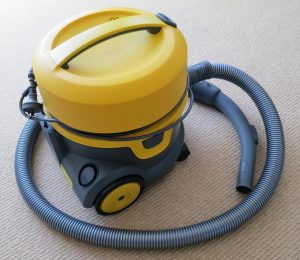Menu image: Large WEEE”by Adam Tinworth is licensed under CC BY-ND 2.0 This section is an excerpt of the original.
| Average Australian home | $6000 a year / 5.7kWh a day / 1.4 ton C02 per year |
|---|---|
| Smart renter | $3000 a year / 3kWh a day / 0.7 ton C02 per year |
| Very smart renter | $1500 a year / 1kWh a day / 0.2 ton C02 per year |
*The energy used to run appliances and gadgets is just a fraction of the total costs of ownership. Total costs include cost of replacement and internet/mobile data connections.
The strategy for smart renters is twofold: Get rid of the appliances that add no real value to your life and make the best use of the ones you want to keep.
Computers
- Unless you use a PC 12 hours a day or more, it makes sense to wait until it wears out to replace it with a more energy efficient computer.
- A $500-$700 laptop now has enough computing power for the needs of most people.
- Laptops use up to 80% less energy than a PC and can replace your TV. Even watching free to air TV is possible with a special USB device.
- As many people own a decent smart phone (which is fine for browsing and watching videos), it is possible to share a computer in a household to minimise ownership costs. This also discourages excessive time spent online.
Gadgets
- “Smart” watches, tablets and E-book readers have not gotten rid of the need for a laptop/PC or smart phone so are they worth buying?
- A smart phone can serve as an E-book reader whilst most travellers can find room for one or two books (which are not much more expensive than an e-book and can be shared or resold).
- If you have a laptop, a smart phone can save you buying a tablet.
- Australians spend $2300 per person per year on Internet of Things devices, so it’s worth pondering the above points [1].

“Smart Gadget Story and UC” by RonanPark is licensed under CC BY 2.0
Phones
- A $150 entry level smart phone can now do what most people use phone for (texting, calls, socal media, web browsing, watching videos, etc.)
- Cheaper phones often have accessible batteries. Cheap replacement batteries can be found on EBay for almost every imaginable phone.
- The other way to prolong the life of a smart phone is not to let the battery run super flat on a regular basis; try recharging your phone at 50% or 70%.
Connectivity
- A big cost of computers, “smart” devices and phones is the cost of connecting to the internet to use them.
- Once you make these devices work for you, this cuts your connectivity costs dramatically.
- A household can comfortably manage on a $50 a month/100GB broadband plan and a $8-$15 a month phone plan for each adult in the house.
- These phone plans have unlimited calls, texting and 1-2GB of data for navigation and a bit of web browsing whilst on the move.
Entertainment appliances
- Using a laptop as a TV is great for living spaces because it can be placed closer to the viewers and a living area can be set up for conversation and reading, not for hours of watching TV.
- The above may be a bit radical for some, so an alternative is to have one TV in the living area which discourages excessive TV time.
- With the availability of home recording devices, it’s easy to catch up on programs later on if two or more people want to watch a different program at the same time.
- If you’re looking for a bit of background entertainment while cooking or cleaning, a radio or stereo uses a lot less power.
Washing machine/dryer and vacuum cleaner

- Detergents are designed to work in cold water so you can save a lot of energy by washing in cold water.
- Airing clothes (except underwear and socks) can help to freshen them saving water, energy and work. Less washing equals longer machine life.
- When your washing machine wears out, a decent front loader or water saving top loader can be had for under $600.
- The best dryer is a washing line and clothes rack. They both cost little and don’t break down.
- For occasional items like drying a doona in the middle of winter, we go to the laundromat.
- If you have no carpet, then a dustpan and broom is fine.
- If you do have carpet, there are lightweight commercial vacuum cleaners that are much sturdier and yet cost just $300 when it comes time to replace your vacuum cleaner.
Kitchen gadgets
- Blenders, milkshake makers, doughnut makers, bread makers, dehydrators, the list goes on. Unless you use these regularly, avoid them as kitchen gadgets are not always built to last and there’s often a simpler way to do the job.
- If you do use a certain device a lot, be prepared to spend on a good quality product; better to buy a good quality one upfront than to go through ten poorly built ones in the same lifespan of a good product.
Power Tools

- Power tools generally don’t make up much of a household power bill unless you use them regularly.
- As with the kitchen, buy only what is useful and buy tool quality to match the job. For example, if you only use a hammer twice a year, an electric nail gun is a waste of money.
- Avoid cordless tools; Corded tools are cheaper to buy and last for a long time because there is no battery that will wear out and may be irreplaceable if the tool is discontinued.
- Also, consider second hand tools; sometimes, you can by a high quality second hand power tool for the same price or even a lower price than a cheap unit that won’t last.
A smart renter may choose to have less appliances and Internet of Things devices than the average household but perhaps a few more than the minimum suggested here, like a TV or a more expensive smart phone or two and spend $3000 a year less than the average Australian home.
Read more: Appliances and gadets article
Further Reading
[1] https://www.linkedin.com/pulse/how-much-do-consumers-spend-digital-technology-may-shock-mcdonald